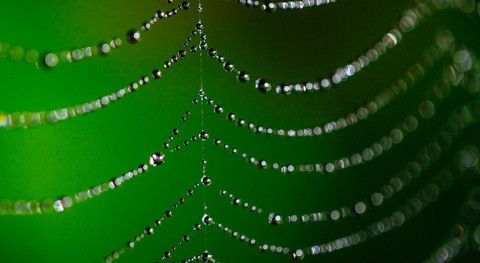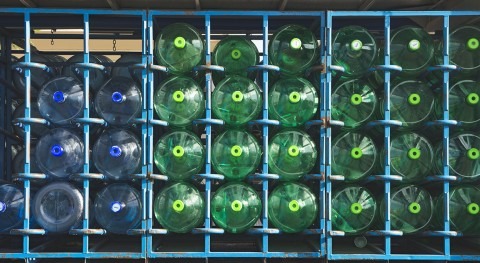Today, a glass of water – our source of life – comes in Switzerland almost for free whilst a commodity like diamonds which is mainly of aesthetic value costs thousands of Swiss francs on the market. How can the difference in price be that large? The view from the water castle of Europe.
Even though water is overall the most important resource sustaining all life on our planet, the daily reality draws a picture that hardly seems consistent. On the one hand, many voices arise today warning about the soon-to-come shortage of this tremendously precious resource – and as we believe at Droople, “every drop counts”. But on the other hand, each of us meets daily situations in which water doesn’t seem to be valued. How can that be?
The work of Carl Menger, founder of the Austrian School of Economics, proposed a consumer view of the Diamond-Water Paradox
In Switzerland, where Droople is located, as well as in many other places, a glass of water comes almost for free whilst a commodity like diamonds which is mainly of aesthetic value (besides some industrial applications such as drilling where diamonds are used) costs thousands of Swiss francs on the market. How can the price difference be that large?
The philosopher Adam Smith is often considered to be the classic presenter of this paradox, although it had already appeared earlier in the work of John Locke or Plato for example. In his book, An Inquiry into the Nature and Causes of the Wealth of Nations, Smith advanced the solution to this question using the concepts of “value in use” and “value in exchange”, namely proposing that the latter is determined by labor needed to acquire a good. By doing so, Smith in fact denied a necessary relationship between price and value. Obviously, from his standpoint, he could not envision a world where it takes great efforts to purify water or where the supply of drinking water may shrink.

The last glaciers
About a century later, the work of Carl Menger, founder of the Austrian School of Economics, proposed a consumer view of the Diamond-Water Paradox. It is based on the marginal utility of a given commodity to its user. According to this theory now known as “marginalism”, it is not the total usefulness of diamonds or water that determines their price, but the usefulness of each additional unit of water or diamonds. This leads us to the conclusion that whilst the total value of water is tremendous in sustaining life, the marginal value of water stays low – as long as water remains in large supply.
Whilst the total value of water is tremendous in sustaining life, the marginal value of water stays low, if it remains in large supply
In Switzerland for instance, large amounts of freshwater are stored in glaciers. But for how long? In fact, most of them are predicted to have disappeared by 2050, whereas the UN warns of a potential 40% shortfall in the global water supply, already by 2030.
About 96% of the total water supply is found in oceans, and there is a broad consensus that an extensive use of desalination will be required to meet the needs of a growing world population. It may happen that this technology eventually transforms oceans into virtual reserves of freshwater, but progress has been slow. According to the International Desalination Association, more than 300 million people worldwide now get their fresh water supply from desalination plants.

Who is paying for the cost of water?
What are the major barriers to its greater use? We must include in the equation the cost of the energy from fossil fuels needed to desalinate, combined with the environmental impacts of the process due to the salt waste. This leads to an increase in greenhouse gas emissions and damages marine life.
This is only one aspect of water treatment. We also need to consider the costs needed to remove groundwater contaminants, such as heavy metals generated by the industrial pollution of water. On top, so-called micropollutants (including some pharmaceutical by-products) are not necessarily removed from drinking water by utilities.
There is a broad consensus that an extensive use of desalination will be required to meet the needs of a growing world population
Worldwide water treatment comes indeed at a high price. One example is Adelaide, Australia. As a result of increasing uncertainty in water imports from the Murray-Darling watershed, the city is now turning towards water recycling and desalination to supplement its water supply in the coming years. The high cost of Adelaide water supply plants causes a serious challenge to city residents: since 2007, water prices rose by more than 400%, which is in large part due to the costs of the installation and the operation of the desalination plant.

Are we heading downstream?
Such seemingly “sudden” cost increases are an echo of historically low water prices that did not reflect the actual costs.
The situation results from the combination of major global trends: a drastically declining water supply coupled with an increasing world population, and its related meat consumption (requiring more water). Adding the rapidly increasing costs of maintaining water quality, one can really question why our society has not started to give more value to water. One may also notice that the decrease in water supply and the corresponding cost increase is not all so “sudden”: it rather is the radical tipping point.
The decrease in water supply and the corresponding cost increase is not all so “sudden”: it rather is the radical tipping point
These changes, however global, materialize differently around the world. In Switzerland for example, both the quantity and quality of the water supply are currently high, whilst the country population is stabilizing and progressively tends to eat less meat. In contrast, just the opposite is true in Malawi: the gap is deepening between the low water supply (both in terms of quantity and quality) and the growing demand, due to the steady increase of population able to afford meat.
Even though water is the most important resource sustaining all life on our planet, the daily reality draws a picture that hardly seems consistent
Challenging the current price of water
In response to these alarming global trends, we sometimes just prefer to believe in the status quo: that water still is and always be cheap and abundant. Without any data on water quality, it is indeed difficult to raise awareness.
Therefore, what will be the most plausible solution to the Water-Diamond Paradox? Considering all these facts, should we question the current price of water?
The discussion about the future of water - its real value and pricing - is as important as urgent, and Droople is ready to take part.
Join us to preserve water – our shared source of life!










